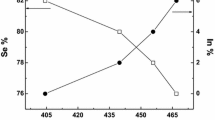Abstract
The concentration dependences of the optical properties of glassy alloys in the HgS-Ga2S3-GeS2 system have been investigated in the spectral range 2.0–2.9 eV. The energy gap E g of glasses has been estimated, and the dependence of the energy gap on the content of HgS and Ga2S3 has been analyzed. The spectral dependences α(hν) for glasses in the system under investigation in the fundamental absorption range are described by the Urbach rule. The alloys containing ≥ 20 mol % (HgS + Ga2S3) are characterized by an ordering and a decrease in the energy gap E g , which are explained by the changes in the short-range order in the arrangement of the atoms involved in the composition of alloys. It has been assumed that, at high concentrations of modifiers, there can arise microscopic inclusions, i.e., different defects, which can scatter light and decrease the transparency of glassy alloys.
Similar content being viewed by others
References
Minaev, V.S., Stekloobraznye poluprovodnikovye splavy (Vitreous Semiconductor Alloys), Moscow: Metallurgiya, 1991 [in Russian].
Munzar, M. and Tichy, L., Far-Infrared Spectra and Bonding Arrangement in Ge-As-S-Se Glasses, J. Phys. Chem. Solids, 2000, vol. 61, no. 10, pp. 1647–1652.
Feltz, A., Pohle, M., Sreil, H., and Herms, G., RDF Studies on the Structure of Vitreous Ge2S3 and Ge2Se3, J. Non-Cryst. Solids, 1985, vol. 69, nos. 2–3, pp. 283–291.
Tverjanovich, A., Grigoriev, Ya.G., Degtyarev, S.V., Kurochkin, A.V., Man’shina, A., Ivanova, T.Yu., Povolotskiy, A., and Tveryanovich, Yu.S., Up-Conversion Luminescence Efficiency in Er-Doped Chalcogenide Glasses, J. Non-Cryst. Solids, 2003, vols. 26–27, no. 1, pp. 311–315.
Ivanova, T.Yu., Man’shina, A.A., Kurochkin, A.V., Tver’yanovich, Yu.S., and Smirnov, V.B., Er3+ to Glass Matrix Energy Transfer in Ga-Ge-S:Er3+ System, J. Non-Cryst. Solids, 2002, vol. 298, no. 1, pp. 7–14.
Olekseuk, I.D., Mazurets, I.I., and Parasyk, O.V., Phase Equilibria in the HgS-Ga2S3-GeS2 System, J. Alloys Compd., 2006, vol. 417, nos. 1–2, pp. 131–137.
Bonch-Bruevich, V.L., Zvyagin, I.P., Keiper, R., Mironov, A.G., Enderlein, R., and Esser, B., Elektronnaya teoriya neuporyadochennykh poluprovodnikov (Electronic Theory of Disordered Semiconductors), Moscow: Fizmatgiz, 1981 [in Russian].
Vainshtein, I.A., Zatsepin, A.F., and Kortov, V.S., Specific Features of the Urbach Rule Manifestation in Vitreous Materials, Fiz. Khim. Stekla, 1999, vol. 25, no. 1, pp. 85–95 [Glass Phys. Chem. (Engl. transl.), 1999, vol. 25, no. 1, pp. 67–74].
Pearson, W.B., The Crystal Chemistry and Physics of Metals and Alloys, New York: Wiley, 1972. Translated under the title Kristallokhimiya i fizika metallov i splavov, Moscow: Mir, 1977.
Klyava, Ya.G., Urbach Rule and Continuum Disorder in Noncrystalline Solids, Fiz. Tverd. Tela (Leningrad), 1985, vol. 27, no. 5, pp. 1350–1353 [Sov. Phys. Solid State (Engl. transl.), 1985, vol. 27, no. 5, pp. 816–817].
Vainshtein, I.A., Zatsepin, A.F., Kortov, V.S., and Shapova, Yu.V., The Urbach Rule for the PbO-SiO2 Glasses, Fiz. Tverd. Tela (St. Petersburg), 2000, vol. 42, no. 2, pp. 224–229 [Phys. Solid State (Engl. transl.), 2000, vol. 42, no. 2, pp. 230–235].
Feltz, A., Amorphe und glasartige anorganische Festkörper, Berlin: Akademie, 1983. Translated under the title Amofnye i stekloobraznye neorganicheskie tverdye tela, Moscow: Mir, 1986.
Point Defects in Solids, Crawford, J.H. and Slifkin, L.M., Eds., New York: Plenum, 1975. Translated under the title Tochechnye defekty v tverdykh telakh, Moscow: Mir, 1979.
Halyan, V.V., Davydyuk, H.Ye., Parasyuk, O.V., and Kevshyn, A.H., The Structure of Glassy HgS-GeS2, Semicond. Phys., Quantum Electron. Optoelectron., 2005, vol. 8, no. 4, pp. 35–37.
Author information
Authors and Affiliations
Corresponding author
Additional information
Original Russian Text © A.H. Kevshyn, V.V. Halyan, H.Ye. Davydyuk, O.V. Parasyuk, I.I. Mazurets, 2010, published in Fizika i Khimiya Stekla.
Rights and permissions
About this article
Cite this article
Kevshyn, A.H., Halyan, V.V., Davydyuk, H.Y. et al. Concentration dependence of the optical properties of glassy alloys in the HgS-Ga2S3-GeS2 system. Glass Phys Chem 36, 27–32 (2010). https://doi.org/10.1134/S1087659610010050
Received:
Published:
Issue Date:
DOI: https://doi.org/10.1134/S1087659610010050




